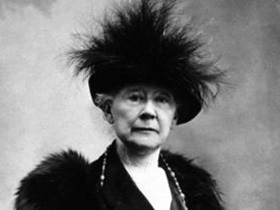Cassatt was born in 1844 into a wealthy family who valued travel as a necessary teaching agent. She studied art briefly in the United States, then moved to Paris where she emulated famous works. Cassatt was heavily influenced by the works of the Impressionists and participated in many of their exhibitions. Cassatt became ill, nearly blind, and eventually died at Chateau de Beaufresne in 1926.
On May 22, 1844, Mary Stevenson Cassatt was born in Allegheny City (now the North Side of Pittsburgh) to her two parents, Robert Simpson and Katherine Kelso Johnston. Cassatt was one of five children in her family, sibling to Lydia Simpson, Alexander Johnston, Robert Kelso, and Joseph Gardner. In 1850, Cassatt and her family moved to Germany, but after the death of her brother Robert, they returned to Pennsylvania. In the spring of 1860, Cassatt enrolled in the Antique Class at the Pennsylvania Academy of the Fine Arts in Philadelphia.
At the age of 21, Cassatt grew frustrated with the lack of paintings by great European artists in America, so she left Philadelphia to travel through Europe to study art. She initially spent her time emulating works in museums, then, in 1868, she met Paul Constant Sayer, who encouraged her to develop her own more modern and realistic style. In 1872, the judges of the Salon in Paris accepted her painting On the Balcony. Then, in 1874, she officially moved to Paris, France.
Cassatt caught the eye of Edgar Degas, a French artist known for his mastery of the human body in motion. Degas proved to be very influential in her life and works by introducing her to the ideas of the Impressionists. For the first time, in 1879, Cassatt participated in the Impressionist Exhibition where she presented eleven paintings.
Aside from painting, Cassatt was dedicated to getting important works into the hands of Americans so art students would not have to face the hardships she encountered while attending school in Pennsylvania. She did this mainly through her brother Alexander, who was the president of the Pennsylvania Rail Road and first major collector of such works in the United States. She also advised Louisine Hevemeyer, a friend of hers, to purchase paintings by Degas, Manet, Monet, Morisot, and Renoir.
Cassatt was also involved in the changes that were occurring in women's lives in both Europe and the United States in the late 1880s. In 1892, she received a commission from the 1893 World's Columbian Exposition in Chicago for a Modern Woman mural to be displayed in the Hall of Honor of the Woman's Building. Cassatt was thrilled because she knew that this opportunity would help promote her art in the US, increase the value of her paintings, and support women's rights. The mural consisted of three panels. The left panel was named Young Women Pursuing Fame and represented three young girls who disregarded society's restrictions on women's success. The middle panel was called Young Women Picking the Fruits of Knowledge and Science. Finally, the right panel was titled, Arts, Music, and Dancing, which depicted the three women from the right after they achieved their success. The mural was a huge success, but unfortunately after the exposition, the Women's Building was pulled down and the mural mysteriously disappeared.
Cassatt bought Chateau de Beaufresne in Mesnil-Theribus to renovate as her summer home in 1894 and lived there with her mother and sister. Throughout the early 1900s, Cassatt continued to paint many new works until the death of her brother, Gardner, in 1912. After his death she was too depressed to paint for two years. In 1914, Cassatt was awarded with the Gold Medal of Honor by the Pennsylvania Academy of the Fine Arts for her high achievement in arts and for her dedication to the cause of art.
Cassatt spent the last few years of her life alone after the majority of her family members died. She also suffered from diabetes, and in 1911, she developed cataracts in both of her eyes. Despite several operations, Cassatt was rendered nearly blind for the remainder of her life. On June 14, 1926, Cassatt died at Chateau de Beaufresne. She now rests in her family's vault near Mesnil-Theribus.
- On a Balcony During a Carnival, 1873; Philadelphia Museum of Art, Philadelphia.
- The Toreador, 1873; Art Institute of Chicago, Chicago.
- Little Girl in a Blue Armchair, 1878; National Gallery of Art, Washington D.C.
- At the Theater, 1879; Nelson-Atkins Museum of Art, Kansas City.
- Woman Reading in a Garden, 1880; Art Institute of Chicago, Chicago.
- Femme Cousant (Young Woman Sewing in the Garden), 1880; Mus??e d'Orsay, Paris.
- The Lamp, 1891; Art Institute of Chicago, Chicago.
- La Toilette, 1891; Art Institute of Chicago, Chicago.
- The Boating Party, 1893; National Gallery of Art, Washington.
- Mother and Child against a Green Background (Maternity), 1897; Mus??e d'Orsay, Paris.
- Mother and Child, 1888; Art Institute of Chicago, Chicago.
- Mother and Child (The Oval Mirror), 1901; The Metropolitan Museum of Art, New York.
- Margot in Blue, 1902; The Walters Art Gallery at Baltimore, Baltimore.
- "200th Anniversary Awards." Pennsylvania Academy of the Fine Arts. 2002. 20 November 2006. <http://web.archive.org/web/20061004101404/http://www.pafa.org/medalOfHonor.jsp>.
- "Cassatt, Mary." WebMuseum, Paris. 2002. 19 November 2006. <http://www.ibiblio.org/wm/paint/auth/cassatt/>.
- Lindsay, Suzanne G. Mary Cassatt and Philadelphia. Philadelphia: University of Pennsylvania Press, 1985.
- "Mary Cassatt." Paul van Rensburg.com. 2003. 20 November 2006. <http://web.archive.org/web/20090530024830/http://www.paulvanrensburg.com/cassatt.html>.
- Mathews, Nancy Mowll. Mary Cassatt. New York: Harry N. Abrams, 1987.
- McDonough, Yona Zeldis. Sisters in Stength: American Women Who Made a Difference. New York: Henry Holt and Company, 2000.
- Shapiro, Barbara Stern. Mary Cassatt at Home. Boston: Museum of Fine Arts, 1978.
- "Tour: Mary Cassatt — Selected Color Prints." The Collection — National Gallery of Art. 2015. 17 September 2015. <http://www.nga.gov/collection/gallery/cassatt/cassatt-main1.html>.
- Webster, Sally. Eve's Daughter/Modern Woman: A Mural by Mary Cassatt. Urbana: University of Illinois Press, 2004.
An Impressionist painter and friend of Edgar Degas, Mary Cassatt was born in Allegheny.

